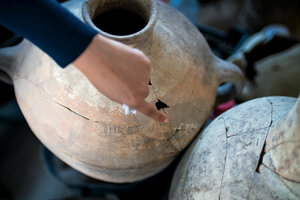A discovery bigger than archaeology
The Middle East is full of groundbreaking archaeological discoveries. What intrigued our correspondent wasn’t what this team uncovered, but who uncovered it.

Egyptologist and ceramics expert Asmaa Ebrahim describes reconstructed pottery found at Aten, a rediscovered city of ancient Thebes in Luxor, Egypt, on Nov. 17, 2022.
Hamada Elrasam/Special to The Christian Science Monitor
Our recent cover story was three years in the making.
I first heard of what is now known as Aten – Egypt’s own Pompeii – back in December 2019. I was speaking with Zahi Hawass, the famous former head of Egyptian antiquities, on the sidelines of Egypt’s World Youth Forum.
It was mostly a courtesy conversation. I was interested to hear about the latest work in Egyptian archaeology. But from my 16 years in the Middle East, I’m always a bit wary of archaeologists who sell their site as “the most important ever” or findings that “change our understanding” of a civilization.
But it was not what Dr. Hawass had discovered that interested me. At that point, his team had not yet broken ground. What interested me was the team itself. For the first time, Dr. Hawass was leading an all-Egyptian team where every role, from conservationist to ceramicist to dig leader to digger to surveyor, was filled by an Egyptian national.
For more than a century, Western archaeologists have been the ones making “discoveries” in Egypt, the Levant, and Mesopotamia. Even in modern joint Arab-international digs, I would watch as foreign archaeologists almost always got the credit, while their local partners would be mainly relegated to the periphery. One major reason for this gap is institutional and financial; Western archaeologists have big-name universities and funds behind them, while Egyptian and other Arab archaeologists often have to pay for their own tools.
The fact that Egyptians were now setting out to uncover more about their own archaeological heritage jumped out to me as an important story to tell.
Unfortunately, the pandemic prevented me from joining Dr. Hawass and his team when they started excavations in 2020. In 2021, they announced their discovery of Aten, an intact, abandoned city from Egypt’s Middle Kingdom. In less than two years, my potential story had a happy ending. But I still wanted to learn more about these archaeologists and tell their story, not just Aten’s.
When I finally arrived at their excavation sites in November 2022, workers were uncovering new artifacts as I stood there: a sandal here, a jewelry workshop there. I met passionate young Egyptian specialists like Asmaa Ebrahim and Siham el-Bershawy, who were uncovering, preserving, and presenting the daily lives of their forebears – work that they are now using toward their Ph.D. studies. These young Egyptian archaeologists expressed hope of one day becoming university professors to pass on their knowledge and experience to the next generation of Egyptians.
What I was witnessing was more than Egyptians gaining a renewed sense of dignity and reclaiming a past that was often told by others. It was a story of the many future Atens to be discovered by the all-Egyptian teams and archaeologists being inspired by this dig. In the end, these young Egyptians’ greatest discovery has been their own ability to lead the field of Egyptology. Through their perspective and independence, they have brought the civilization of their ancestors to life.

